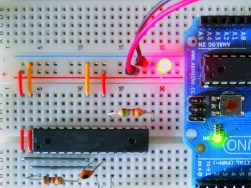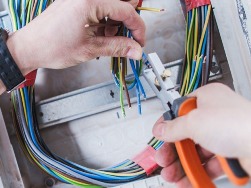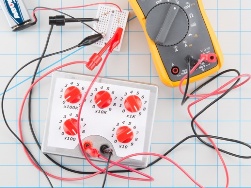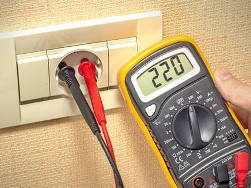Types of modern integrated circuits - types of logic, cases
 All modern microcircuits are divided into three types: digital, analog and analog-digital, depending on what type of signals they work with. Today we’ll talk about digital microcircuits, since most microcircuits in electronics are digital, they work with digital signals.
All modern microcircuits are divided into three types: digital, analog and analog-digital, depending on what type of signals they work with. Today we’ll talk about digital microcircuits, since most microcircuits in electronics are digital, they work with digital signals.
A digital signal has two stable levels - a logical zero and a logical unit. For microcircuits made according to different technologies, the levels of logical zero and unity differ. Various elements can be located inside digital microcircuits, the names of which are known to any electronic engineer: RAM, ROM, comparator, adder, multiplexer, decoder, encoder, counter, trigger, various logic elements, etc. Today, digital circuits of TTL technologies are most common. and CMOS. In TTL technology chips, the zero level is ...
What is a gyroscope and accelerometer
 Many modern devices and gadgets have gyroscopes and accelerometers built into them. Smartphones, video and cameras, tablets, readers, etc. - these devices are found almost everywhere, although their presence is not at all noticeable if you look at the device from the outside. The gyroscope is also called the gyro sensor, and the accelerometer is called the G-sensor. Working in pairs, these devices perfectly complement each other, providing usability and flexibility of the gadget functions.
Many modern devices and gadgets have gyroscopes and accelerometers built into them. Smartphones, video and cameras, tablets, readers, etc. - these devices are found almost everywhere, although their presence is not at all noticeable if you look at the device from the outside. The gyroscope is also called the gyro sensor, and the accelerometer is called the G-sensor. Working in pairs, these devices perfectly complement each other, providing usability and flexibility of the gadget functions.
The accelerometer in its simplest form is a weight mounted on a spring, installed in its own housing. When shaking or turning the body, the weight moves inside it by inertia. And since the weight moves during acceleration in the corresponding direction, it inevitably pulls the spring along with it, the oscillations of which can be taken into account to determine the direction and accelerate the change in the position of the entire body. So, three springs with weights installed along ...
Someone is right on the Internet! Or what do electricians say
 Forums and social networks have long been the place to address many, including professional, issues. Often, experienced professionals turn to colleagues for advice. So, installers are looking for the support of designers in terms of knowledge of standards, and designers ask "practitioners" about the actual installation conditions of this or that equipment. True, some tasks are so complex that they cannot immediately find the truth and a dispute erupts. Let's try to figure out three frequent discussions.
Forums and social networks have long been the place to address many, including professional, issues. Often, experienced professionals turn to colleagues for advice. So, installers are looking for the support of designers in terms of knowledge of standards, and designers ask "practitioners" about the actual installation conditions of this or that equipment. True, some tasks are so complex that they cannot immediately find the truth and a dispute erupts. Let's try to figure out three frequent discussions.
How many places do you need to choose boxing? Given: in the electrical diagram of the switchboard, an automatic switch VA 47-29 3P 63 A for input, five differential automatic machines 12 12P 16 A / 30 mA and seven VA 47-29 1P 10 A are provided. Side one: “A 24-seater shield is needed : 20 places are taken, we add a reserve of 20%, that is, four more places. ” The second side: “You should not even take less than 36 positions. It is very difficult to dodge in boxing space at 24, and all that needs to be installed there ...
Why does the switch open the phase, not the zero?
 Any switch that is responsible for turning on and off the light in a room, for example, must open the phase, and not zero. A phase in an AC network is one of the conductors on which alternating voltage is constantly present with respect to the neutral conductor. The zero conductor, ideally, has zero potential with respect to earth, which always remains so in a healthy network, since the zero conductor is, by definition, grounded.
Any switch that is responsible for turning on and off the light in a room, for example, must open the phase, and not zero. A phase in an AC network is one of the conductors on which alternating voltage is constantly present with respect to the neutral conductor. The zero conductor, ideally, has zero potential with respect to earth, which always remains so in a healthy network, since the zero conductor is, by definition, grounded.
Whether the network is three-phase or single-phase, the neutral (neutral) conductor must be earthed, so it is, in principle, much safer than the phase conductor.In fact, generators and transformers have grounding, from which the electric network receives energy. If the neutral conductor is not grounded, it means that an accident has occurred in the network, a break of the neutral conductor.Usually in everyday life we use single-pole switches, that is, those that open or close just one wire ...
The use of the Wheatstone bridge for measuring non-electric quantities
 Wheatstone Bridge is an electrical circuit designed to measure the magnitude of electrical resistance. This scheme was first proposed by British physicist Samuel Christie in 1833, and in 1843 it was improved by inventor Charles Wheatstone. The principle of operation of this scheme is similar to the action of mechanical pharmacy scales, but it is not the forces that are equalized here, but the electric potentials.
Wheatstone Bridge is an electrical circuit designed to measure the magnitude of electrical resistance. This scheme was first proposed by British physicist Samuel Christie in 1833, and in 1843 it was improved by inventor Charles Wheatstone. The principle of operation of this scheme is similar to the action of mechanical pharmacy scales, but it is not the forces that are equalized here, but the electric potentials.
The Wheatstone bridge circuit contains two branches, the potentials of the middle terminals (D and B) of which are equalized during the measurement process. One of the branches of the bridge includes a resistor Rx, the resistance value of which must be determined. The opposite branch contains a rheostat R2 - adjustable resistance. Between the middle terminals of the branches, the G indicator is on, which can be a galvanometer, a voltmeter, a zero indicator or an ammeter ...
 The development of electronics and semiconductor technology in the early 21st century has led to the fact that no modern car can do without an extensive power supply network, called the car's on-board network. The vehicle’s on-board network is a direct current power system, and includes both sources and consumers of electric energy. While the thermal energy of the burned fuel is directly suitable only for providing mechanical movement, electric energy is universal, and is able to power a variety of devices, ranging from lamps in headlights to a spark ignition system.
The development of electronics and semiconductor technology in the early 21st century has led to the fact that no modern car can do without an extensive power supply network, called the car's on-board network. The vehicle’s on-board network is a direct current power system, and includes both sources and consumers of electric energy. While the thermal energy of the burned fuel is directly suitable only for providing mechanical movement, electric energy is universal, and is able to power a variety of devices, ranging from lamps in headlights to a spark ignition system.
So, there are only two sources of energy in a car: a battery (usually lead-acid) and a generator that receives mechanical rotation directly from an internal combustion engine. And since the battery is also a consumer during recharging, then the main source of energy in a modern car ...
What stress is dangerous to human life?
 The problem of the danger of electric shock is known to everyone from an early age. Parents are afraid that the child accidentally crawls into the outlet, and regularly warn him against this. However, despite all the warnings, electric shocks happen, sometimes, unfortunately, fatal. This applies to both children and adults, and even professionals with experience.
The problem of the danger of electric shock is known to everyone from an early age. Parents are afraid that the child accidentally crawls into the outlet, and regularly warn him against this. However, despite all the warnings, electric shocks happen, sometimes, unfortunately, fatal. This applies to both children and adults, and even professionals with experience.
As a rule, the tragedy happens by chance, maybe a person neglected safety procedures at work, showed carelessness or simply overlooked the health of the household appliance in everyday life. In any case, the human factor always takes place - the person is to blame. In the end, it was man who electrified the world, of course, we do not take lightning lightning into account. It doesn’t matter whether a person has come under low voltage or high, the defeat may be imperceptible or completely insignificant, but it always exists. It is important to understand that the determining factor in the lesion is ...
Transformers and autotransformers - what is the difference and feature
 Various electrical equipment and modern electrical networks as a whole use primarily AC for their work. Alternating current feeds engines, induction furnaces, machine tools, computers, heaters, electric heaters, lighting devices, household appliances.
Various electrical equipment and modern electrical networks as a whole use primarily AC for their work. Alternating current feeds engines, induction furnaces, machine tools, computers, heaters, electric heaters, lighting devices, household appliances.
It is impossible to overestimate the importance of alternating current for the modern world. However, high voltage is used to transmit electrical energy over long distances.And the equipment requires a low voltage for its power supply - 110, 220 or 380 volts. Therefore, after transmitting to a distance, the voltage must be reduced. Lowering is carried out in steps using transformers and autotransformers. In general, transformers are up and down. Step-up transformers are installed in generating power plants, where they increase received from the generator ...
